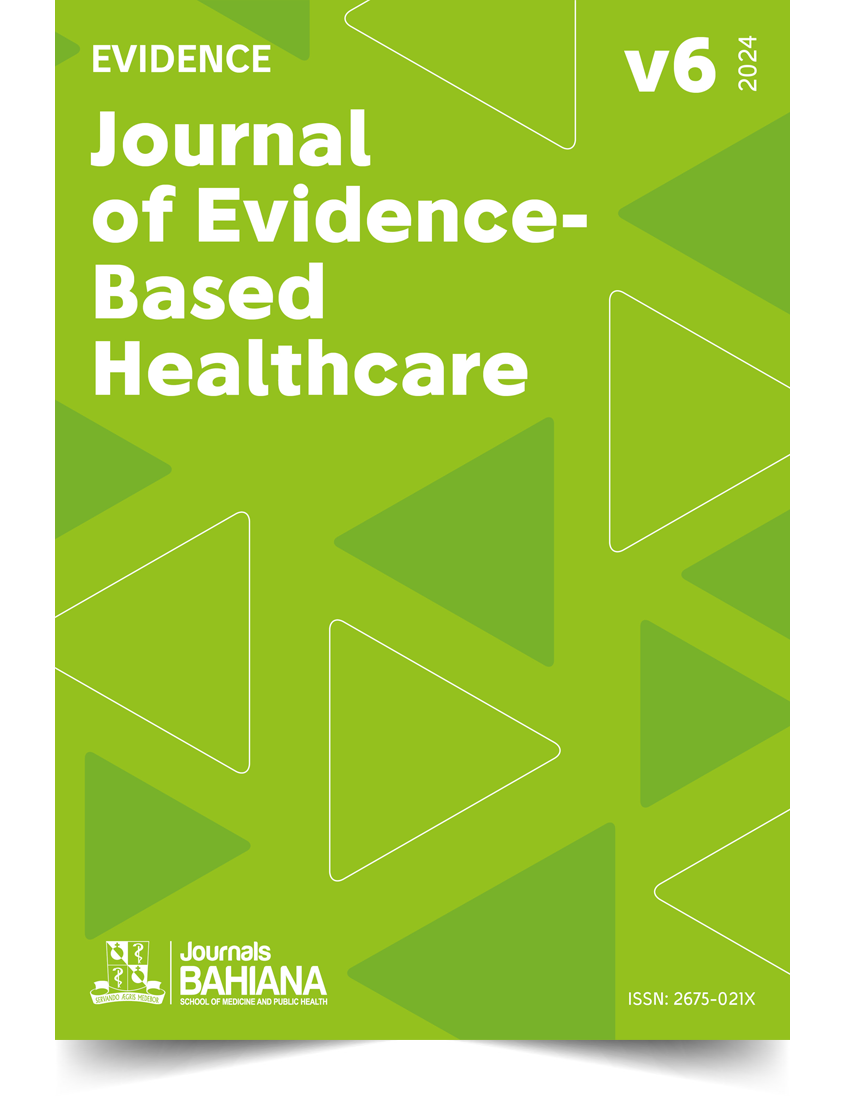When math legitimizes knowledge: a step by step approach to Bayes’ rule in diagnostic reasoning
DOI:
https://doi.org/10.17267/2675-021Xevidence.2024.e5903Keywords:
Probability, Clinical Decision-Making, Diagnostic ErrorsAbstract
INTRODUCTION: Many mistakes in clinical practice arise from confusing the probability of a positive test in those with the disease and the probability of having the disease in those who test positive. This misunderstanding leads to overestimating disease probability, diagnosing diseases in healthy individuals, ordering invasive diagnostic tests, and prescribing unnecessary treatments, resulting in unjustified adverse effect, psychological stress, and increased cost. Probabilistic reasoning is an essential skill to mitigate this confusion, and Bayes theorem is an important tool to accomplish this goal. OBJECTIVE: To present a step-by-step demonstration of Bayes' formula for positive and negative predictive values, fostering understanding and enabling its adoption in evidence-based medicine education and clinical practice as a supporting tool in the decision-making process. METHODS: In this article, we explain the difference between deductive and inductive thinking and how diagnostic reasoning is predominantly inductive, where evidence (the test result) is used to predict the cause (the presence of disease), a path that involves reverse probability, for which our reasoning is hazier. Through a clinical example involving the diagnosis of systemic lupus erythematosus, we use the Bayesian framework as a tool to help understand the difference between sensitivity/specificity (forward probability; deductive) and positive/negative predictive values (reverse probability: inductive). CONCLUSIONS: Excellent doctors are masters at applying Bayesian reasoning without using any formulas: they understand that the most important component of the diagnostic process is the reasoning that originates it and the resulting clinical decision depends on interpreting results considering their interaction with the context, not in isolation. Bad clinical reasoning results in bad clinical decisions, despite how accurate the diagnostic test: garbage in, garbage out. We hope our step-by-step approach to Bayes' rule can help demystify this powerful statistical tool and strengthen the idea that the value of a diagnostic test is directly proportional to the quality of clinical reasoning that led to its request.
Downloads
References
(1) Morgan DJ, Pineles L, Owczarzak J, Magder L, Scherer L, Brown JP, et al. Accuracy of Practitioner Estimates of Probability of Diagnosis Before and After Testing. JAMA Intern Med. 2021;181(6):747-55. https://doi.org/10.1001/jamainternmed.2021.0269
(2) White T, Algeri S. Estimating the lifetime risk of a false positive screening test result. PLoS One. 2023;18(2):e0281153. https://doi.org/10.1371/journal.pone.0281153
(3) Fenton JJ, Weyrich MS, Durbin S, Liu Y, Bang H, Melnikow J. Prostate-Specific Antigen-Based Screening for Prostate Cancer: Evidence Report and Systematic Review for the US Preventive Services Task Force. JAMA. 2018;319(18):1914-31. https://doi.org/10.1001/jama.2018.3712
(4) Lee JM, Arao RF, Sprague BL, Kerlikowske K, Lehman CD, Smith RA, et al. Performance of Screening Ultrasonography as an Adjunct to Screening Mammography in Women Across the Spectrum of Breast Cancer Risk. JAMA Intern Med. 2019;179(5):658-67. https://doi.org/10.1001/jamainternmed.2018.8372
(5) Frank JW. Occult-blood screening for colorectal carcinoma: the risks. Am J Prev Med. 1985;1(4):25-32. https://doi.org/10.1016/S0749-3797(18)31396-5
(6) Ismail AA. When laboratory tests can mislead even when they appear plausible. Clin Med (Lond). 2017;17(4):329-32. https://doi.org/10.7861/clinmedicine.17-4-329
(7) Brodersen J, Siersma VD. Long-term psychosocial consequences of false-positive screening mammography. Ann Fam Med. 2013;11(2):106-15. https://doi.org/10.1370/afm.1466
(8) Morgan DJ, Brownlee S, Leppin AL, Kressin N, Dhruva SS, Levin L, et al. Setting a research agenda for medical overuse. BMJ. 2015;351:h4534. https://doi.org/10.1136/bmj.h4534
(9) Elstein AS, Schwartz A. Clinical problem solving and diagnostic decision making: selective review of the cognitive literature. BMJ. 2002;324(7339):729-32. https://doi.org/10.1136/bmj.324.7339.729
(10) Kassirer JP. Diagnostic reasoning. Ann Intern Med. 1989;110(11):893-900. https://doi.org/10.7326/0003-4819-110-11-893
(11) Bayes T, Price R, Molina EC, Deming WE. An Essay towards solving a Problem in the Doctrine of Chances: Hafner; 1963. https://doi.org/10.1098/rstl.1763.0053
(12) Bours MJ. Bayes' rule in diagnosis. J Clin Epidemiol. 2021;131:158-60. https://doi.org/10.1016/j.jclinepi.2020.12.021
(13) Cosby K, Yang D, Fineberg HV. Assessing Diagnostic Performance. NEJM Evid. 2024;3(2):EVIDra2300232. https://doi.org/10.1056/evidra2300232
(14) Manrai AK, Bhatia G, Strymish J, Kohane IS, Jain SH. Medicine's uncomfortable relationship with math: calculating positive predictive value. JAMA Intern Med. 2014;174(6):991-3. https://doi.org/10.1001/jamainternmed.2014.1059
(15) Akobeng AK. Understanding diagnostic tests 1: sensitivity, specificity and predictive values. Acta Paediatr. 2007;96(3):338-41. https://doi.org/10.1111/j.1651-2227.2006.00180.x
(16) Hoi A, Igel T, Mok CC, Arnaud L. Systemic lupus erythematosus. Lancet. 2024;403(10441):2326-38. https://doi.org/10.1016/s0140-6736(24)00398-2
(17) Leuchten N, Hoyer A, Brinks R, Schoels M, Schneider M, Smolen J, et al. Performance of Antinuclear Antibodies for Classifying Systemic Lupus Erythematosus: A Systematic Literature Review and Meta-Regression of Diagnostic Data. Arthritis Care Res (Hoboken). 2018;70(3):428-38. https://doi.org/10.1002/acr.23292
(18) Li QZ, Karp DR, Quan J, Branch VK, Zhou J, Lian Y, et al. Risk factors for ANA positivity in healthy persons. Arthritis Res Ther. 2011;13(2):R38. https://doi.org/10.1186/ar3271
(19) Norman GR, Brooks LR. The Non-Analytical Basis of Clinical Reasoning. Adv Health Sci Educ Theory Pract. 1997;2(2):173-84. https://doi.org/10.1023/a:1009784330364
(20) Kilkenny MF, Robinson KM. Data quality: "Garbage in - garbage out". Health Inf Manag. 2018;47(3):103-5. https://doi.org/10.1177/1833358318774357
(21) Akobeng AK. Understanding diagnostic tests 2: likelihood ratios, pre- and post-test probabilities and their use in clinical practice. Acta Paediatr. 2007;96(4):487-91. https://doi.org/10.1111/j.1651-2227.2006.00179.x
(22) McGee S. Simplifying likelihood ratios. J Gen Intern Med. 2002;17(8):646-9. https://doi.org/10.1046/j.1525-1497.2002.10750.x
(23) Fagan TJ. Letter: Nomogram for Bayes's theorem. N Engl J Med. 1975;293(5):257. https://doi.org/10.1056/nejm197507312930513
(24) Greenhalgh T. How to read a paper. Papers that report diagnostic or screening tests. BMJ. 1997;315(7107):540-3. https://doi.org/10.1136/bmj.315.7107.540
(25) Binder K, Krauss S, Schmidmaier R, Braun LT. Natural frequency trees improve diagnostic efficiency in Bayesian reasoning. Adv Health Sci Educ Theory Pract. 2021;26(3):847-63. https://doi.org/10.1007/s10459-020-10025-8
Downloads
Published
Issue
Section
License
Copyright (c) 2024 Yung Bruno de Mello Gonzaga, André Demambre Bacchi, Vitor Borin Pardo de Souza

This work is licensed under a Creative Commons Attribution 4.0 International License.
The authors retain copyrights, transferring to the Journal of Evidence-Based Healthcare only the right of first publication. This work is licensed under a Creative Commons Attribution 4.0 International License.



